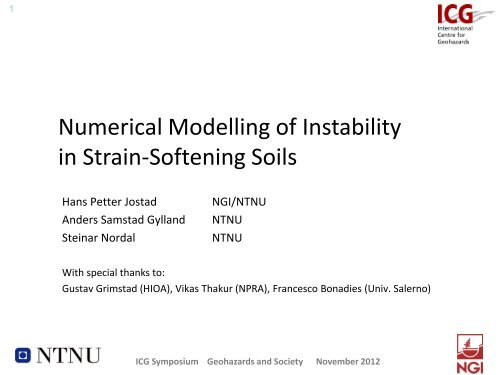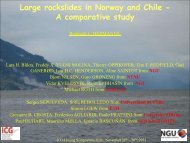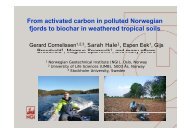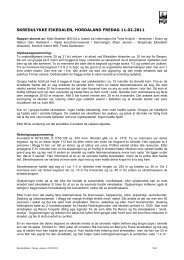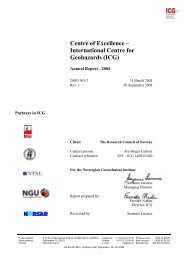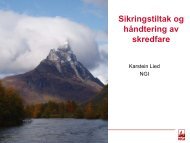Numerical Modelling of Instability in Strain-Softening Soils - NGI
Numerical Modelling of Instability in Strain-Softening Soils - NGI
Numerical Modelling of Instability in Strain-Softening Soils - NGI
You also want an ePaper? Increase the reach of your titles
YUMPU automatically turns print PDFs into web optimized ePapers that Google loves.
1<strong>Numerical</strong> <strong>Modell<strong>in</strong>g</strong> <strong>of</strong> <strong>Instability</strong><strong>in</strong> Stra<strong>in</strong>-S<strong>of</strong>ten<strong>in</strong>g <strong>Soils</strong>Hans Petter JostadAnders Samstad GyllandSte<strong>in</strong>ar Nordal<strong>NGI</strong>/NTNUNTNUNTNUWith special thanks to:Gustav Grimstad (HIOA), Vikas Thakur (NPRA), Francesco Bonadies (Univ. Salerno)ICG Symposium Geohazards and Society November 2012
2Stra<strong>in</strong>-S<strong>of</strong>ten<strong>in</strong>g <strong>Soils</strong>LoadPeakReduction <strong>in</strong> resistance for<strong>in</strong>creas<strong>in</strong>g deformationLoadStra<strong>in</strong>s<strong>of</strong>ten<strong>in</strong>gResidualSensitiveclayDisplacementICG Symposium Geohazards and Society November 2012
3KaareHöeg1972
4Stra<strong>in</strong>-S<strong>of</strong>ten<strong>in</strong>g <strong>Soils</strong>• Smårød, 20.12.06ICG Symposium Geohazards and Society November 2012
5Stra<strong>in</strong>-S<strong>of</strong>ten<strong>in</strong>g <strong>Soils</strong>• Kattmarkveien 13.03.09ICG Symposium Geohazards and Society November 2012
6Stra<strong>in</strong>-S<strong>of</strong>ten<strong>in</strong>g <strong>Soils</strong>• Esp 01.01.12Photo:Ned Alley/ScanpixICG Symposium Geohazards and Society November 2012
7Stra<strong>in</strong>-S<strong>of</strong>ten<strong>in</strong>g <strong>Soils</strong>• Esp 01.01.12Photo: KRISTOFFER FURBERGICG Symposium Geohazards and Society November 2012
8Sensitive clay• Deposited <strong>in</strong> salt water• Landrise• Fresh water <strong>in</strong>filtration– House-<strong>of</strong>-cards without glue• Liquefies when remoulded– Quick clay: s r < 0.5 kPawww.forskn<strong>in</strong>g.nowww.ngu.noICG Symposium Geohazards and Society November 2012
9Sensitive clay• CIUc triaxial tests, block samples Tiller quick clayICG Symposium Geohazards and Society November 2012
10Sensitive clay• CIUc triaxial tests, block samples Tiller quick clayICG Symposium Geohazards and Society November 2012
(ICSMFE Mexico, 1969)ICG Symposium Geohazards and Society November 2012
12Stig Bernander:Surte slide 1950,Tuve slide 1977PhD 2011ICG Symposium Geohazards and Society November 2012
RIGID SPRINGSCOMPRESSIBLE SPRINGSΔΔNNFTF1Tδ 1 -δ 22δ 2 -δ 33TδTδTδTTδ 1δ 2Tδ 3FFΔΔICG Symposium Geohazards and Society November 2012
ICG Symposium Geohazards and Society November 2012τ 0 > c R
ICG Symposium Geohazards and Society November 2012
16Downward progressive failureLong natural slopeEABar on weak layerForceWeak layerICG Symposium Geohazards and Society November 2012
17Downward progressive failureEAForceABWeak layerδ Aδ A ≠ δ Bδ BxICG Symposium Geohazards and Society November 2012
19Downward progressive failureEAForceABWeak layerStra<strong>in</strong>s<strong>of</strong>ten<strong>in</strong>gτAδ Aδ A ≠ δ BτBδ Bxτδδτ 0Initial shear stressxICG Symposium Geohazards and Society November 2012
20Downward progressive failureEAForceABWeak layerStra<strong>in</strong>s<strong>of</strong>ten<strong>in</strong>gτAδ Aδ A ≠ δ BτBδ Bxτ 0δ δInitial shear stressxICG Symposium Geohazards and Society November 2012
21Downward progressive failure• Slope resistance depends on:StiffnessPeak strengthS<strong>of</strong>ten<strong>in</strong>g behaviourτ 0Initial shearstress level• Higher resistance for:– Higher stiffness– Higher peak strength– Lower rate <strong>of</strong> stra<strong>in</strong> s<strong>of</strong>ten<strong>in</strong>g (perfect plastic = zero stra<strong>in</strong> s<strong>of</strong>ten<strong>in</strong>g)– Lower <strong>in</strong>itial stress levelxICG Symposium Geohazards and Society November 2012
22Downward progressive failure• Initial shear stress level– Highly sensitive– 10% change <strong>of</strong> the <strong>in</strong>itialshear stress level gives a40-50% change <strong>of</strong> thecapacity• Stiffness– Sensitive for low values• S<strong>of</strong>ten<strong>in</strong>g– Sensitive for low values– Uncerta<strong>in</strong> parameterICG Symposium Geohazards and Society November 2012
24Stra<strong>in</strong>-S<strong>of</strong>ten<strong>in</strong>g <strong>Soils</strong>LoadPeakReduction <strong>in</strong> resistance for<strong>in</strong>creas<strong>in</strong>g deformationLoadStra<strong>in</strong>s<strong>of</strong>ten<strong>in</strong>gResidualSensitiveclayDisplacementICG Symposium Geohazards and Society November 2012
25Downward progressive failureICG Symposium Geohazards and Society November 2012
26Localized failure - shear bandsICG Symposium Geohazards and Society November 2012
27S<strong>of</strong>ten<strong>in</strong>g gives mesh dependencyδΤδΤγ 1t 1γ 2t 2W 1 W 1 > W W 22LLττ 1τ 2γ 1 γ 2γΤ21δICG Symposium Geohazards and Society November 2012
28Regularisation technique <strong>in</strong> order to obta<strong>in</strong>mesh <strong>in</strong>dependent solution4Need a procedure that gives a capacity orsafety factor that is mesh <strong>in</strong>dependent.L o a d p / s u C32Shear band thickness:tsb = 150 cmtsb = 50 cmtsb = 1 cmThis means that the solution shouldconverge upon mesh ref<strong>in</strong>ements and theshear band thickness should be larger thangiven by the element size.10(Andresen /Jostad)0 0.01 0.02 0.0300 D i s p l a c e m e n t δ m a xICG Symposium Geohazards and Society November 2012
Regularization – non-local stra<strong>in</strong>p*p pα( ) ( ) ( ) (p∆ ε x =∆ε x −α⋅∆ ε x + ∫ w( x) ⋅∆ε ( x)) dVi i iVδhτγ pt sbControl <strong>of</strong> the shear band thicknessγ
1D shear columnNormalized shear stress (τ/su)1.00.90.80.70.60.50.40.30.20.1α = 1.58, l/L = 0.1 => t/L =π/101 el10 el20 el50 elMesh <strong>in</strong>dependent solutionwhen the element size issmaller than the shearband thickness!0.00.0 2.0 4.0 6.0 8.0 10.0 12.0 14.0 16.0 18.0 20.0Normalized displacement δ/L [%]τδ1 elThe shear band thickness isdef<strong>in</strong>ed by the s<strong>of</strong>ten<strong>in</strong>g zone!10 el20 el50 el100100100100Lγt sbNormailzed position (x/L) [%]806040Normailzed position (x/L) [%]806040Normailzed position (x/L) [%]806040Normailzed position (x/L) [%]8060402020202000 10 20 3000 10 20 3000 10 20 3000 10 20 30Normalized displacement (δ/L) [%]Normalized displacement (δ/L) [%]Normalized displacement (δ/L) [%]Normalized displacement (δ/L) [%]
Slope stability problem“Almost” mesh <strong>in</strong>dependent results!
32Problem:The shear band is mm scale, elements are m scaleTrick for FEM simulations:Increas<strong>in</strong>g the <strong>in</strong>ternal length by reduc<strong>in</strong>g the s<strong>of</strong>ten<strong>in</strong>g stra<strong>in</strong>, ∆γ s<strong>of</strong>t∗Shear stress, τPeak∆γ s<strong>of</strong>t∗ ∙l <strong>in</strong>ternal * = ∆γ s<strong>of</strong>t ∙ l <strong>in</strong>ternalResidualOnly really OK for 1D problems∆γ s<strong>of</strong>t∗Shear stra<strong>in</strong>, γICG Symposium Geohazards and Society November 2012
Material model – <strong>NGI</strong>-ADPS<strong>of</strong>tτs uCf( σ,γp)= τ −su( α,γp)s uDSSα = 0 os urCσ zzσ 14 5 oτ xzτo9 0 oγzασ xxs uE
34Smårød, 20.12.06ICG Symposium Geohazards and Society November 2012
Slides by Francesco Bonadies, Univ. SalernoVolume [m 3 ] 750.000Length [m] 200Width [m]500Slip surface [m] 15Three ma<strong>in</strong> phases:- area A first- area B next,- area C f<strong>in</strong>alA fill <strong>of</strong> about 7 meters is the trigger<strong>in</strong>g agent ?Simulated by <strong>NGI</strong>-ADPS<strong>of</strong>t as part <strong>of</strong> the SVV-NVE project :Effekt <strong>of</strong> progressive failure on physical development <strong>of</strong> areas with quick clay
Slides by Francesco Bonadies, Univ. Salerno• dry crust• s<strong>of</strong>t clay layer• firm bottom123123
37SmårødICG Symposium Geohazards and Society November 2012
38SmårødICG Symposium Geohazards and Society November 2012
Slides by Francesco Bonadies, Univ. SalernoTrigger<strong>in</strong>gembankmentOldembankmentRiver190 mPr<strong>in</strong>cipal total stra<strong>in</strong>s directions
Slides by Francesco Bonadies, Univ. SalernoInput
Slides by Francesco Bonadies, Univ. Salerno
Effect <strong>of</strong> updated geometry <strong>in</strong> analyses <strong>of</strong> progressive failureUpdated geometry is important for captur<strong>in</strong>g the f<strong>in</strong>al slide configurationGylland, A. & Jostad, H.P (2010) NUMGEICG Symposium Geohazards and Society November 2012
Initial stresses are difficult to evaluate:Masterthesis Magne Mehli, vår 2010ICG Symposium Geohazards and Society November 2012
How important is stra<strong>in</strong> s<strong>of</strong>ten<strong>in</strong>g forevaluat<strong>in</strong>g the stability <strong>of</strong> a slope?Key project:Effekt <strong>of</strong> progressive failure on physicaldevelopment <strong>of</strong> areas with quick clayThanks to:
Effect <strong>of</strong> s<strong>of</strong>ten<strong>in</strong>g:Karlsrud/<strong>NGI</strong>Handbook 016standard psamples?Prelim<strong>in</strong>ary results from <strong>NGI</strong> project:Effekt <strong>of</strong> progressive failure on physicaldevelopment <strong>of</strong> areas with quick clay
46Modified triaxial cell• Mov<strong>in</strong>g, low friction base sled• Instrumented• Planar shear bands• Why triax?– Optimal sample handl<strong>in</strong>g and quality– Ma<strong>in</strong>ta<strong>in</strong> relevance <strong>of</strong> tested materialICG Symposium Geohazards and Society November 2012
47Excess pore pressure• Stra<strong>in</strong> s<strong>of</strong>ten<strong>in</strong>g by excess pore pressure• Characteristic consolidation time ≈ lab test time• Internal pore pressure gradientsPlastic shear<strong>in</strong>gGeneration <strong>of</strong> excesspore pressureElastic unload<strong>in</strong>gReciever <strong>of</strong> excesspore pressureICG Symposium Geohazards and Society November 2012
48Micro CT, PhD work A. GyllandICG Symposium Geohazards and Society November 2012
49Conclud<strong>in</strong>g remarks• <strong>Numerical</strong> Model<strong>in</strong>g <strong>of</strong> <strong>Instability</strong> <strong>in</strong> Stra<strong>in</strong>-S<strong>of</strong>ten<strong>in</strong>g <strong>Soils</strong> is still difficult,but may now be done <strong>in</strong> a consistent manner• The <strong>NGI</strong> – ADPS<strong>of</strong>t with non-local stra<strong>in</strong> is a powerful tool• A pragmatic «effect <strong>of</strong> s<strong>of</strong>ten<strong>in</strong>g factor» is studied, 10% ?• Old message repeated: Prevent the <strong>in</strong>itial slide!• More research needed:– Understand<strong>in</strong>g material behaviour– Scal<strong>in</strong>g the s<strong>of</strong>ten<strong>in</strong>g curve only exact for 1D– Initial stresses are hard to determ<strong>in</strong>e, but has high <strong>in</strong>fluence– Effective stress based simulations wanted Ge<strong>of</strong>uture• Design codes and guidel<strong>in</strong>esICG Symposium Geohazards and Society November 2012
50Thank you ICG !ICG Symposium Geohazards and Society November 2012


